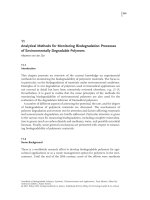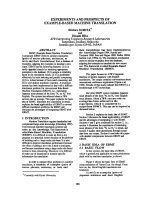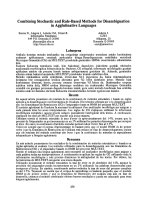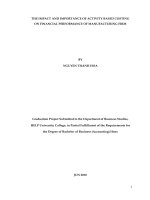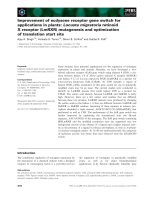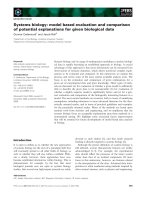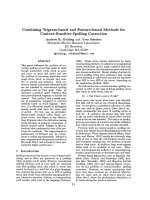Development, evaluation and optimization of image based methods for monitoring crystallization processes
Bạn đang xem bản rút gọn của tài liệu. Xem và tải ngay bản đầy đủ của tài liệu tại đây (10.13 MB, 214 trang )
DEVELOPMENT, EVALUATION AND
OPTIMIZATION OF IMAGE BASED METHODS
FOR MONITORING CRYSTALLIZATION
PROCESSES
ZHOU YING
NATIONAL UNIVERSITY OF SINGAPORE
2011
DEVELOPMENT, EVALUATION AND
OPTIMIZATION OF IMAGE BASED METHODS
FOR MONITORING CRYSTALLIZATION
PROCESSES
ZHOU YING
(M.Sc., National University of Singapore,
B.Eng., Dalian University of Technology, China)
A DISSERTATION SUBMITTED
FOR THE DEGREE OF DOCTOR OF PHILOSOPHY
DEPARTMENT OF CHEMICAL AND BIOMOLECULAR
ENGINEERING
NATIONAL UNIVERSITY OF SINGAPORE
2011
i
Acknowledgements
I would like to dedicate this thesis to the memory of my father, Mr. Chuanfu Zhou.
No words can express my great respect and reverence to him. I could never have
begun this thesis without his endless love, unconditional support and unselfish
consideration from his heart and soul.
I would like to express my sincere gratitude to my main supervisor, Prof.
Rajagopalan Srinivasan, for his invaluable guidance, encouragement and patience
throughout my project. He has offered me precious advice on how to face
challenges and supported me to pass through the hardest time both in my work
and life. He has spent time teaching me how to write proper research papers and
patiently revised my drafts of papers over and over. The experience learnt from
Prof. Raj has made me a more independent and confident researcher.
I am especially grateful to my co-supervisor Prof. Samavedham
Lakshminarayanan, for his constant instruction, support, valuable comments and
suggestions.
Deep appreciation also goes to Mr. Xuan-Tien Doan, Dr. Debasis Sarkar, Dr.
Zaiqun Yu, Ms. Jia Wei Chew, Dr. Ann Chow, Dr. Shaohua Feng, Dr. Jie Bu, Ms.
Angeline Seo, Ms. Agnes Nicole Phua Chiew Lian and other colleagues and
lab-mates, for their efforts and assistance. It is a pleasant experience to work with
ii
them together.
I would also like to acknowledge the National University of Singapore (NUS) for
offering me the chance to pursue this degree, and gratefully acknowledge the
Institute of Chemical and Engineering Sciences (ICES) for funding the project
and providing me with the lab, experimental equipment and very good studying
and working environment.
In particular, I would like to thank Rong Xu, Shoucang Shen, Zhan Wang, Feng
Gao, David Wang, Shuyi Xie, Jin Xu, Yi Li, Liangfeng Guo, Kian Soon and
many other close friends for sharing my joys and sadness, listening to my
complaints, giving me advice, and having an unforgettable time together.
Last but not least, I would like to express my deepest gratitude to my family, my
mother, Fuqin Liu, my brother, Wei Zhou, my husband, Donglin Shi and my
daughter, Yuexin Shi for giving me persistent encouragement and support.
Zhou Ying
May 2011
iii
Table of Contents
ACKNOWLEDGEMENTS I
TABLE OF CONTENTS III
SUMMARY VII
LIST OF FIGURES IX
LIST OF TABLES XIII
LIST OF SYMBOLS XIV
CHAPTER 1. INTRODUCTION 1
1.1 CHALLENGES IN IN-LINE IMAGING FOR CRYSTALLIZATION 2
1.2 OBJECTIVES AND MAIN CONTRIBUTIONS 6
1.3 THESIS STRUCTURE 8
CHAPTER 2. REAL-TIME MONITORING AND CONTROL OF
CRYSTALLIZATION PROCESSES 9
2.1 IMPORTANT SPECIFICATIONS OF PRODUCT QUALITY IN CRYSTALLIZATION
PROCESSES 10
2.1.1 Important Sepcifications for Crystallization Process 11
2.1.2 Factors Affecting Crystallization Process 15
2.2 CURRENT IN SITU INSTRUMENTS FOR CRYSTALLIZATION PROCESS
MONITORING AND CONTROL 17
2.2.1 Attenuated Total Reflectance Fourier Transform Infrared Spectroscopy 17
2.2.2 Focused Beam Reflectance Measurement (FBRM) 19
2.2.3 Raman and Near-Infrared Spectroscopy (NIR) 23
2.2.4 Real-Time Imaging System for Crystallization 25
iv
2.3 PROCESS IMAGING IN CHARACTERIZING PARTICLE SIZE AND SHAPE 33
2.3.1 Image Analysis Based Approach for PSD Estimation 35
2.4 MAJOR IMAGE ANALYSIS STEPS 38
2.4.1 Edge Detection 40
2.4.2 Morphology Operation 42
2.4.3 Feature Extraction 44
2.5 CONCLUSIONS 46
CHAPTER 3. NEW DEVELOPMENTS OF ON-LINE IMAGE ANALYSIS
METHODOLOGIES 47
3.1 IMAGE SELECTION 47
3.2 IMAGE ENHANCEMENT 50
3.3 PARTICLE SELECTION 53
3.4 SIZE ESTIMATION 56
3.5 OVERALL STEPS OF IMAGE ANALYSIS (IA) METHODOLOGIES 58
3.6 CONCLUSION 64
CHAPTER 4. EXPERIMENTAL STUDIES 65
4.1 EXPERIMENTAL SETUP 65
4.2 EXPERIMENTS 68
4.2.1 Experiments with Sea Sand 69
4.2.2 Seeded Cooling Crystallization of MSG from DI Water 70
4.3 DISCUSSION 81
4.3.1 Comparison of Image Quality 81
4.3.2 Speed of PVM Imaging 91
4.4 CONCLUSION 94
CHAPTER 5. METRICS FOR EVALUATING PVM IMAGING SYSTEM AND
IA METHODOLOGY 95
5.1 METRICS FOR EVALUATING IA RESULTS 97
5.2 EVALUATION OF PVM IMAGING SYSTEM AND IA METHODOLOGY 101
v
5.3 CONCLUSION 103
CHAPTER 6. EVALUATION OF IA METHODOLOGY FOR REAL-TIME
MONITORING OF PARTICLE GROWTH IN SEEDED MSG
CRYSTALLIZATION 105
6.1 EFFECT OF IMAGE ANALYSIS PARAMETERS ON PSD ESTIMATES 105
6.2 IA-BASED REAL-TIME MONITORING OF PARTICLE GROWTH IN SEEDED MSG
CRYSTALLIZATION 114
6.3 CONCLUSION 117
CHAPTER 7. OPTIMIZATION OF IMAGE PROCESSING PARAMETERS 119
7.1 INTRODUCTION 119
7.2 METHODS FOR PARAMETERS OPTIMIZATION 124
7.2.1 Model-Based Optimization with Uniform Design 125
7.2.2 Variable-Size Sequential Simplex Optimization 128
7.2.3 Integration of Two Optimization Approaches 132
7.3 OPTIMIZATION OF IA PARAMETERS 133
7.3.1 Optimization with Uniform Design Method: Model Solving by
Simplex 134
7.3.2 Optimization with Sequential Simplex Optimization 140
7.3.3 Comparison of the Two Optimization Methods 153
7.4 CONCLUSION 155
CHAPTER 8. CONCLUSIONS AND FUTURE WORKS 156
8.1 CONCLUSIONS 156
8.2 FUTURE WORK 158
8.2.1 Segment-Based Image Fusion 159
8.2.2 Further Methods for Particle Segmentation 166
8.2.3 Improving the Methodology to Analyze Complex Images 169
8.2.4 Calibrating the Measurements of Microscope, FBRM and PVM 173
8.2.5 New Methodology: Using Manually Built Templates 173
vi
8.2.6 Closed Loop Control of Crystallization Processes Using Image-Based
Sensors 174
BIBLIOGRAPHY 176
APPENDIX A LIST OF PUBLICATIONS 193
vii
Summary
Monitoring and control of particulate processes is quite challenging and has
evoked recent interest in the use of image-based approaches to estimate product
quality (e.g. size, shape) in real-time and in situ. Crystal size estimation from
video images, especially for high aspect-ratio systems, has received much
attention. In spite of the increased research activity in this area, there is little or no
work that demonstrates and quantifies the success of image analysis (IA)
techniques to any reasonable degree. This is important because, although image
analysis techniques are well developed, the quality of images from inline sensors
is variable and often poor, leading to incorrect estimation of the process state.
This thesis studies large-scale size estimation with Lasentec’s in-process video
imaging system, PVM. It seeks to fill this void by focusing on one key step in IA
viz. segmentation. Using manual segmentation of particles as an independent
measure of the particle size, we have devised metrics to compare the accuracy of
automated segmentation during IA. These metrics provide a quantitative measure
of the quality of results. A Monosodium Glutamate seeded cooling crystallization
process is used to illustrate that, with proper settings, IA can be used to accurately
track the size within ~8% error.
Any image processing algorithm involves a number of user-defined parameters
and, typically, optimal values for these parameters are manually selected. Manual
viii
selection of optimal image processing parameters may become complex,
time-consuming and infeasible when there are a large number of images and
particularly if these images are of varying quality, as could happen in batch
crystallization processes. This thesis combines two optimization approaches to
systematically locate optimal sets of image processing parameters – one approach
is a model-based optimization approach used in conjunction with uniform
experimental design; another approach is the sequential simplex optimization
method. Our study shows that these two approaches or a combination of them can
successfully locate the optimal sets of parameters and the image processing
results obtained with these parameters are better than those obtained via manual
tuning. Combination of these two approaches also helps to overcome the
drawbacks of the two individual methods. Our work also demonstrates that the
optimal sets of parameters obtained from one batch of process images can also be
successfully applied to another batch of process images obtained from the same
system. The in-process video microscopy (PVM) images that are acquired from
Monosodium Glutamate (MSG) seeded cooling crystallization process are used to
demonstrate the workability of the proposed approach.
ix
List of Figures
Figure 1.1. Problems with in-line imaging system 5
Figure 2.1. Definition of metastable zone 13
Figure 2.2. Photo of ATR probe 18
Figure 2.3. Structure diagram of FBRM 19
Figure 2.4. Structure of PVM System 29
Figure 2.5. Steps in image analysis 39
Figure 2.6. Comparison of two kinds of bounding box 44
Figure 2.7. Feature extraction of segmented particle 45
Figure 3.1. Comparison of the intensity histogram of images with and without
MSG particles inside 49
Figure 3.2. Comparison of the intensity histogram of images with and without
silica gel particles inside 51
Figure 3.3. Problem of non-uniform background 52
Figure 3.4. Reference image 52
Figure 3.5. Effect of image enhancement 53
Figure 3.6. Signature curve for segmented and smoothed particles 55
Figure 3.7. Particle size estimation from signature curve 57
Figure 3.8. Proposed methodology for on-line image analysis 58
Figure 3.9. Steps in image analysis of silica gel PVM image 59
Figure 3.10. Steps in image analysis of sea sand PVM image 60
x
Figure 3.11. Steps in image analysis of sea salt PVM image 61
Figure 3.12. Steps in image analysis of MSG PVM image 62
Figure 3.13. Steps in image analysis of sea salt & MSG mixture PVM Image
63
Figure 4.1. Experimental setup 66
Figure 4.2. Schematic diagram of experimental setup 68
Figure 4.3. PVM images of sea sand particles of various size ranges 71
Figure 4.4. FBRM measurements of sea sand particles of various size ranges
72
Figure 4.5. Microscopy images of sea sand particles of various size ranges 73
Figure 4.6. Molecular structure of l-glutamic acid monosodium salt monohydrate
74
Figure 4.7. Solubility measured by ATR-FTIR and evaporation approaches
75
Figure 4.8. ATR-FTIR spectra collected at different concentration and
temperature from the solution of MSG in DI water 76
Figure 4.9. Temperature profile for MSG seeded crystallization process 78
Figure 4.10. Microscopy images of prepared MSG seeds with 50X magnification
79
Figure 4.11. PVM images acquired at evenly-distributed process time from
experiment X of MSG seeded cooling crystallization
84
Figure 4.12. PVM images acquired at evenly-distributed process time from
experiment A of MSG seeded cooling crystallization
85
Figure 4.13. PVM images acquired at evenly-distributed process time from
experiment B of MSG seeded cooling crystallization
xi
86
Figure 4.14. PVM images acquired at evenly-distributed process time from
experiment C of MSG seeded cooling crystallization
87
Figure 4.15. PVM images acquired at evenly-distributed process time from
experiment D of MSG seeded cooling crystallization
88
Figure 4.16. Time series PVM images acquired from experiment X 89
Figure 4.17. Intensity histogram variations corresponding to Figure 4.16 90
Figure 4.18. Mean intensity variations with time corresponding to experiment X
91
Figure 4.19. Number of images acquired in each hour with different settings of
image acquisition speed 93
Figure 4.20. Hourly performance with different settings of image acquisition
speed 93
Figure 5.1. Segmentation of a MSG particle 97
Figure 6.1. Examples of IA, Template 1 and Template 2 segmentation of the same PVM
images
107
Figure 6.2. Quality of image analysis results 113
Figure 6.3. Time evolution of extent of matching and cumulative error during
experiment X 114
Figure 6.4. Median particle size during experiment X estimated from image
analysis and manual segmentation 115
Figure 6.5. Two hourly particle size distribution during experiment X. 116
Figure 6.6. Growth of particles during four MSG crystallization experiments
117
Figure 7.1. Procedure of optimization with design of experiments 126
xii
Figure 7.2. Procedure of variable-size sequential simplex optimization 129
Figure 7.3. Parameters and responses of 105 experimental runs of UD 136
Figure 7.4. Comparison of model prediction and experimental validation 137
Figure 7.5. Effect of step size in sequential simplex optimization 144
Figure 7.6. IA parameters and responses of all optimal vertexes (With ER>12)
147
Figure 7.7. Comparison of original image and human segmentation for two image
sets 150
Figure 8.1. Clearly imaged representative particles can be identified by multiple
image processing methodologies 162
Figure 8.2. Estimated PSD for 5 sets of sea sand images 164
Figure 8.3. Improvement of every 4 Hours’ PSD estimation for MSG seeded
cooling crystallization by fusing the segmentations from IA and MIA
165
Figure 8.4. Definition of solidity 167
Figure 8.5. Application of solidity filter to ignore particles with irregular shapes
167
Figure 8.6. Single particle segmentation by shrinking bounding box 168
Figure 8.7. Samples for 4 sets of complex images 170
Figure 8.8. IA segments particles from image set 2, 3, and 4 171
Figure 8.9. Identify long needle-shape particles by finding lines 172
xiii
List of Tables
Table 2.1 Parameters for Various Weights of FBRM Measurements 21
Table 4.1 Experiments for Calibrating ATR-FTIR 77
Table 4.2 Comparison of Different Runs of MSG Seeded Cooling Crystallization
Experiments 81
Table 5.1 Size Estimates of Sea Sand Particles using Microscopy and Image
Analysis 102
Table 6.1 Effects of IA Parameters on Image Analysis Performance 108
Table 6.2 Effects of Morphology Structuring Elements on Image Analysis
Performance 109
Table 6.3 Optimal IA Parameters for PVM Images from MSG Crystallization 111
Table 7.1 Typical Initial Design of Simplex 130
Table 7.2 7 Factors 6 Levels Uniform Design of IA Parameters 135
Table 7.3 Validation of Predicted Optimal Parameters for Uniform Design 139
Table 7.4 SSO Performance with Different Initial Guess and Step Size (1st set of
images) 142
Table 7.5 Performance of 1
st
Set Images’ Optimal Parameters on 2
nd
Set Images
149
Table 7.6 SSO Performance with Different Initial Guess and Step Size (2
nd
set of
images) 152
xiv
List of Symbols
ALD: Axis Length Distribution
ATR-FTIR: Attenuated Total Reflectance Fourier Transform Infrared
B: Binary Image
CCD: Charge-Coupled Device
CLD: Chord Length Distribution
CLD
Max
: Maximum chord length
CLD
Min
: Minimum chord length
CMOS: Complementary Metal Oxide Semiconductor
CT: Computerized Tomography
DFT: Discrete Fourier Transform
DOE: Design of Experiments
FBF: Feature-Based Image Fusion
FBRM: Focused Beam Reflectance Measurement (FBRM)
FDA: US Food and Drug Administration
GP: Genetic Programming
IA: Image Analysis
MIA: Multivariate Image Analysis
MSG: Monosodium Glutamate
xv
NIR: Near-Infrared
PAT: Process Analytical Technology
PIA: Particle Image Analysis
PSD: Particle Size distribution
PVM: In-Process Video Microscopy
RBF: Region-Based Image Fusion
S: Structuring Element (in morphology operation)
SSO: Sequential Simplex Search
UD: Uniform Design
),( yxC
: Canny edge detected image
i
C
: concentration of solute i, [g/g or %]
*
i
C
: equilibrium concentration of solute i, [g/g]
C
: concentration difference, [g/g]
C
R
: contracted vertex to reflection side in SSO
C
W
: contracted vertex to W side in SSO
ji
d ,
: Euclidean distance between two pixels
E
: cumulative error
E
i
: expanded coordinate of the i
th
parameter in SSO
xvi
G
E
: median error of particle size estimation for one image
ER
: ratio of
A
M
to E
yxG ,
: Gaussian filter mask
),( yxI
: original image
),(
~
yxI
: enhanced image
),(
~
~
yxI
: filtered image
Ref
(, )
I
xy: reference image
max
I
: maximum image intensity
min
I
: minimum image intensity
I
: image intensity range
i
: coordinates of the i
th
outline pixel
M
: Canny edge magnitude
A
M
: extent of matching
N: the next-to-the-worst vertex
: ordered coordinates (2-d) pixels of particle’s outline
: centroid position calculated from particle’s outline
xvii
: maximum chord length calculated from particle’s outline
P
i
: centroid point of the i
th
parameter in SSO
R
i
: reflected coordinate of the i
th
parameter in SSO
S
: supersaturation ratio
S
i
: step size in SSO
k
T : user-defined threshold value for image intensity range
min
T : user-defined threshold value for minimum image intensity
v
i,j
: value of i
th
parameter in j
th
vertex
W: the worst vertex in SSO
X
i
: initial guess of the i
th
parameter in SSO
YX
, : coordinate position of object in image
(
i
r ,
i
): signature curve of object’s outline
: standard deviation of the Gaussian smoothing filter
: Canny edge direction
: user-defined threshold value to identify same particle from different
segmentation
p
: error in particle’s length estimation
Chapter 1 Introduction
1
Chapter 1. Introduction
Crystallization is a critical process in pharmaceutical, fine chemical,
petrochemical, food, and semiconductor manufacturing industries. In
crystallization operations (Myerson, 2002; Quirk & Serda, 2002; Yu &
MacGregor, 2003), particle size and shape are important specifications of product
quality that need to be well-controlled. For a pharmaceutical product, the
dissolution rate, bioavailability and therapeutic effects depends significantly on
the particle size and shape. A narrow particle size distribution with specific
particle shape is often indicative of good product quality.
Real-time monitoring and control of the crystallization process is important to
ensure that the desired final product quality is achieved. Traditionally, the control
of crystallization processes has relied extensively on empirical experience.
Complex chemistries, non-availability of detailed models, and the lack of in situ
sensors to directly measure product quality have been the main reasons for this
state of affairs. The lack of in situ sensors is felt in other particulate processes
such as filtration, drying and granulation as well. Although technologies for
offline particle size and shape measurements such as microscopy have been
available and widely used, it is but recently that in-line measurements are
Chapter 1 Introduction
2
becoming possible. Technologies such as Focused Beam Reflectance
Measurement (FBRM) and In-Process Video Microscopy (PVM), both from
Lasentec / Mettler Toledo, are widely used in manufacturing units to monitor
particle size distribution and shape variation. With the advances in real-time
imaging hardware and the concomitant developments in image analysis
technology, there is an opportunity to monitor crystallization processes by
processing in-situ images.
Section 1.1 will discuss the challenges in processing in-situ images. Our main
contributions will be summarized in Section1.2. The thesis structure will be
introduced in Section 1.3.
1.1 Challenges in In-Line Imaging for Crystallization
The numerous benefits of extracting product, process, and phenomena
characteristics from in-situ images are conditional on accurate assessment of the
particle size and shape from the images. Although, the various steps of image
analysis are well-established and have been used in several crystallization systems,
it is widely acknowledged (Patience et al. 2001; Braatz, 2002; Larsen et al. 2006a)
that the extraction of information from in-situ images remains a challenging task
for several reasons:
Chapter 1 Introduction
3
The in-process video offers a 2-d image of 3-d objects with the consequent
loss of information.
Unlike the images used in classical image analysis literature where the objects
of interest change slowly, crystallization involves stirred solutions, and
particles move at high speeds (vis-à-vis the field of view and the imaging rate).
As a corollary, even with tens of images per second, the same particle cannot
be guaranteed to be present in contiguous images. This precludes noise
cancellation by averaging across samples (images). Further, the usual
complications in capturing images of objects in motion occur including
random orientations, and out-of-focus objects.
In situations where classical image analysis is widely applied, the
‘background’ can be considered stationary in space and time with respect to
the objects of interest. In crystallization systems, the background is a stirred
solution – therefore, images suffer from various aberrations such as
background noise, bubbles, time-changing intensity and contrast, etc.
Currently, there is no image processing algorithm that can perform well under
varying image qualities. The algorithms have been largely customized to
specific applications – both the specific image processing steps and their
Chapter 1 Introduction
4
parameters would need adjustment for a given crystallization system. Even
within one system, there may be significant intra-run variability in the
background and the quality of images. This makes it difficult to apply any one
method or one set parameters to process all the images from different process
stages. During a batch crystallization run, the solid concentration typically
increases as the crystals nucleate and grow. The imaging system thus acquires
blank images (of the background) at the beginning, and images with many
overlapping crystals in a high solid-concentration background towards the
later stages. As the run proceeds, the contrast of the images varies with time
and the capability to extract information reliably from the images deteriorates
considerably. As an additional complication, at high solid-concentrations, the
crystals may aggregate or agglomerate, making accurate particle segmentation
even more challenging.
Finally, to effectively track the process in real-time, the image-processing
algorithm must not only be accurate and robust, but also capable of matching
the speed at which images are acquired. The current rate of image acquisition
is up to 30 images/second for charge-coupled device (CCD) camera and 10
images/second for PVM.
Chapter 1 Introduction
5
(a) Partially imaged particle (b) Out of focus particle
(c) Uneven background (d) Particle not clearly imaged
(e) Far-away big particles are imaged
as small ones
(f) Long particles overlap and
partially imaged
(g) Uneven background and out of
focus particles
(h) High aggregation of long particles
Figure 1.1. Problems with in-line imaging system.
Chapter 1 Introduction
6
Fig. 1.1 demonstrates the common problems that may be encountered with in-line
imaging systems. Since the lens has limited field of view, long particles should be
at the center of the image to be fully imaged. The longer a particle grows, the
higher the possibility that the particle would only be partially imaged. Fig. 1.1(a),
(f) and (h) show partially imaged particles. Random imaging of moving particles
in a stirred slurry may also cause further problems of unclearly imaged particles
(Fig. 1.1 (b) and (d)), uneven background (Fig. 1.1 (c)) and far away big particles
may be imaged as small particles (Fig. 1.1 (e)). With the progress of
crystallization process, more and more particles nucleate and grow bigger.
Consequently, the solid concentration increases and particles aggregate, as shown
in Fig. 1.1 (f), (g) and (h). With these common problems, it is not easy to
precisely segment particles and characterize particle size and shape from in-line
process images. Because of these challenges, it is important develop specific
improvements targeted at PVM images.
1.2 Objectives and Main Contributions
Direct observation is now believed to be the best way to monitor particle shape
and size (Yu et al., 2004). Process images can provide more realistic
two-dimensional information on particle shape and size and help us better
understand the process (Scott, 2005; Scott & McCann, 2005; Li et al., 2006).
However, there is still a gap between the information obtained from advanced

